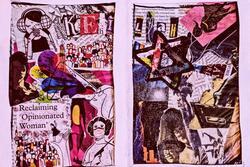Protest Social Media's Beauty Standards in the Name of the Freedom Trash Can
The 1960s and 1970s were major decades for social change: the legalization of abortion, greater equality in splitting childcare, increased division of household responsibilities between married couples, and the Miss America Protest. And behind each example on this particular list was activist Alix Kates Shulman, who challenged societal norms as part of a group called New York Radical Women (NYRW). In my view, Shulman’s statements about beauty standards and the Miss America Protest serve as an origin story for the focus on one of today’s key feminist issues: societal expectations around appearance for women.
The NYRW organized a protest at the Atlantic City Boardwalk, the location of the Miss American Pageant, in 1968. The group was protesting what they saw as the pageant’s dehumanizing displays of women’s bodies and creation of unreasonable beauty standards. The protest, which quickly became known as the Miss America Protest, was one of the first national protests of the women’s liberation movement. Approximately 400 feminists from all over the East Coast came together on the Atlantic City Boardwalk to make themselves heard. Shulman was one of the main orchestrators of the demonstration, and later said that “this particular demonstration was personal” for her; she felt “very strongly about the oppressiveness of beauty standards” and the effect they had both on her and on society as a whole.
In 2021, society's widespread internet usage and social media addictions have led to rocketing beauty expectations for women. Although social media is often fun and amusing, its effects can also be quite harmful. In order to keep up appearances online or follow the lead of influencers, many women strive to present themselves as flawless, following a model of “perfection” drilled into their brains by social media stars. With the help of technology and apps, people can alter the way they look in both videos and photographs until they achieve the look they want—one that usually adheres to a specific beauty standard. This reliance on Photoshop and Facetune isn’t helped by the internet’s tendency to tear down women for the littlest details about their appearances and to fixate on their physical features.
This widespread digital morphing of women’s faces and bodies is harmful. When someone changes the way they look in a picture, they may achieve a moment of relief as they feel they’ve grasped that concept of “perfection” or meeting the standard; but that feeling is overshadowed by the fact that it's not the person’s actual appearance. The phenomenon of photoshopping social media posts is a complicated one but, ultimately, it’s undeniable that our current beauty standards are devastatingly unattainable. I think that Shulman’s approach—organizing a demonstration and attacking the core of the issue—has amazing potential; however, today’s beauty standards are largely rooted in individuals’ technology, so there’s no physical location or event outside of which to picket or protest. So, how can contemporary feminists make their own statement?
I think we could harness the power of social media itself for our protest; we could all demonstrate together in carefully-chosen places like the mall, a famous photo wall, or in a publicly photographed place, and create a viral image or video in order to spread our message. Along with physical protests, organized online protests could be effective with action items like: making digital signs, creating hashtags, posting on our stories, creating activism accounts, and leaving positive (instead of negative) comments. We can spread the word that society's standards and expectations don’t define anyone’s worth or identity. Social media can be used to bring down women, but it can also be used to build up, support, and advocate for them as well.
In the pre-social media era, the Miss America Protest organizers used other means to spread the word about their cause: they wrote newspaper articles, rallied feminists to join, and together, they burned bras, hairspray, girdles, corsets, makeup, fake lashes, and other feminine products in a trash can labeled “freedom trash can.” While rebelling against societal norms of beauty, these activists harnessed the power of images to draw attention to their cause.
Alix Kates Shulman’s involvement in organizing and spreading the word about the Miss American Protest demonstrates her lasting impact on the feminist movement, especially as we continue to rebel today against beauty standards. Contemporary feminists can learn so much from Shulman, not only about the strength and impact of protest but also about how we can utilize tools of images and documentation to make sure our voices are heard everywhere. Shulman refused to be silenced, and so should we as we tackle oppressive, harmful norms that permeate both our digital and real lives.
This piece was written as part of JWA’s Rising Voices Fellowship.







